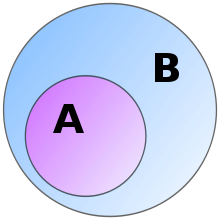User:Phlsph7/Algebra - Universal algebra
Universal algebra
[edit]Universal algebra is the study of algebraic structures in general. It is a generalization of abstract algebra that is not limited to binary operations and allows operations with more inputs as well, such as ternary operations. Universal algebra is not interested in the specific elements that make up the underlying sets and instead investigates what structural features different algebraic structures have in common.[1] One of those structural features concerns the identities or axioms that are true in different algebraic structures. In this context, an identity is a universal equation or an equation that is true for all elements of the underlying set. For example, commutativity is a universal equation that states that is identical to for all elements.[2] Two algebraic structures that share all their identities are said to belong to the same variety.[3] For instance, the ring of integers and the ring of polynomials form part of the same variety because they have the same identities, such as commutativity and associativity. The field of rational numbers, by contrast, does not belong to this variety since it has additional identities, such as the existence of multiplicative inverses.[4]
Besides identities, universal algebra is also interested in structural features associated with quasi-identities. A quasi-identity, also referred to as Horn clause, is an identity that only needs to be present under certain conditions. It is a generalization of identity in the sense that every identity is a quasi-identity but not every quasi-identity is an identity. Algebraic structures that share all their quasi-identities have certain structural characteristics in common, which is expressed by stating that they belong to the same quasivariety.[5]

Homomorphisms are a tool in universal algebra to examine structural features by comparing two algebraic structures.[6] A homomorphism is a function that takes the elements of the underlying set of one algebraic structure as input and has the elements of the underlying set of another algebraic structure as output. Its special feature is that it preserves certain structural characteristics of the algebraic structures. If the two algebraic structures use binary operations and have the form and then the function is a homomorphism if it fulfills the following requirement: . The existence of a homomorphism reveals that the operation in the second algebraic structure plays the same role as the operation does in the first algebraic structure.[7]
Another tool of comparison is the relation between an algebraic structure and its subalgebra.[8] If is a subalgebra of then the set A is a subset of B.[a] A subalgebra has to use the same operations as the algebraic structure[b] and they have to follow the same axioms. This includes the requirement that all operations in the subalgebra are closed in A, meaning that they only produce elements that belong to A.[10] For example, the set of even integers together with addition is a subalgebra of the full set of integers together with addition. This is the case because the sum of two even numbers is again an even number. But the set of odd integers together with addition is not a subalgebra since adding two odd numbers produces an even number, which is not part of the chosen subset.[11]
Notes
[edit]References
[edit]- Artamonov, V. A. (15 October 2003). "Quasivarieties". In Hazewinkel, M. (ed.). Handbook of Algebra. Elsevier. ISBN 978-0-08-053297-4.
- Cox, David A.; Little, John; O'Shea, Donal (30 April 2015). Ideals, Varieties, and Algorithms: An Introduction to Computational Algebraic Geometry and Commutative Algebra. Springer. ISBN 978-3-319-16721-3.
- Silvia, M. T.; Robinson, E. A. (1 January 1979). Deconvolution of Geophysical Time Series in the Exploration for Oil and Natural Gas. Elsevier. ISBN 978-0-08-086864-6.
- Grätzer, George (2008). Universal Algebra (2 ed.). Springer. ISBN 978-0-387-77486-2.
- Insall, Matt; Sakharov, Alex. "Universal Algebra". Wolfram MathWorld. Wolfram. Retrieved 12 January 2024.
- Mal’cev, A. I. (1973). "Quasivarieties". Algebraic Systems. Springer. ISBN 978-3-642-65374-2.
- Indurkhya, Bipin (9 March 2013). "6.5 Algebras and Structures". Metaphor and Cognition: An Interactionist Approach. Springer Science & Business Media. ISBN 978-94-017-2252-0.
- Mal'cev, Anatolij Ivanovic (6 December 2012). Algebraic Systems. Springer Science & Business Media. ISBN 978-3-642-65374-2.
- ^
- Pratt 2022, § 3. Universal Algebra
- Insall & Sakharov
- ^
- Pratt 2022, § 3.2 Equational Logic
- Mal’cev 1973, pp. 210–211
- Insall & Sakharov
- ^
- Pratt 2022, § 3. Universal Algebra
- Mal’cev 1973, pp. 210–211
- ^
- ^
- Mal’cev 1973, pp. 210–211
- Pratt 2022, § 3. Universal Algebra
- Artamonov 2003, p. 873
- ^
- Insall & Sakharov
- Pratt 2022, § 3.3 Birkhoff’s Theorem
- Grätzer 2008, p. 34
- ^
- Pratt 2022, § 3.3 Birkhoff’s Theorem
- Insall & Sakharov
- Silvia & Robinson 1979, p. 82
- ^
- Indurkhya 2013, pp. 217–218
- Pratt 2022, § 3.3 Birkhoff’s Theorem
- Grätzer 2008, p. 34
- ^ Indurkhya 2013, pp. 217–218
- ^
- Indurkhya 2013, pp. 217–218
- Pratt 2022, § 3.3 Birkhoff’s Theorem
- Grätzer 2008, p. 34
- ^ Indurkhya 2013, pp. 217–218









